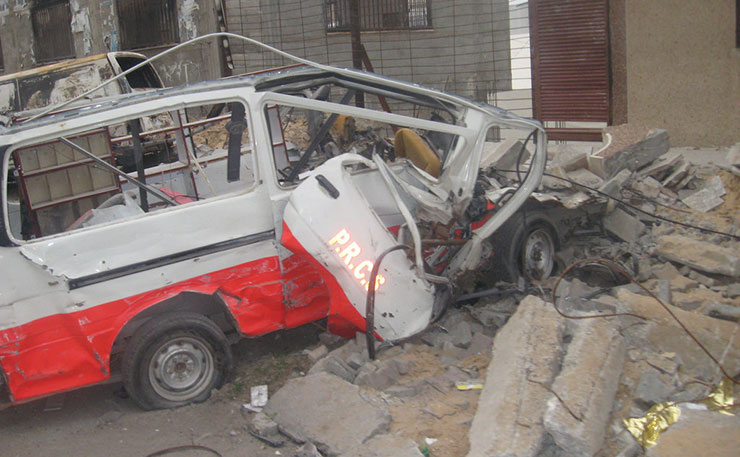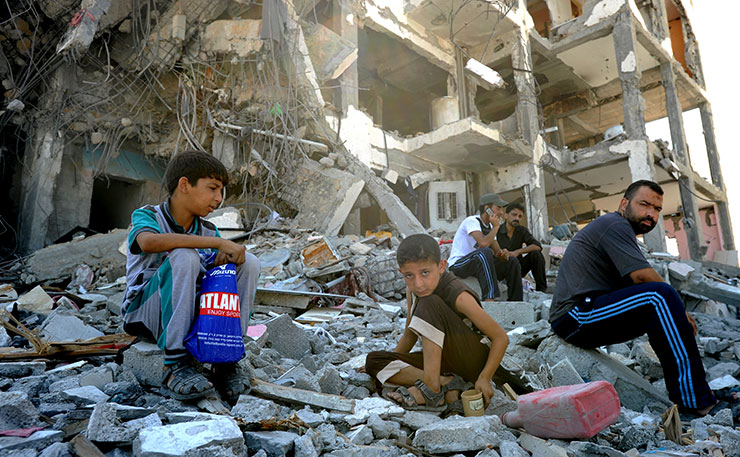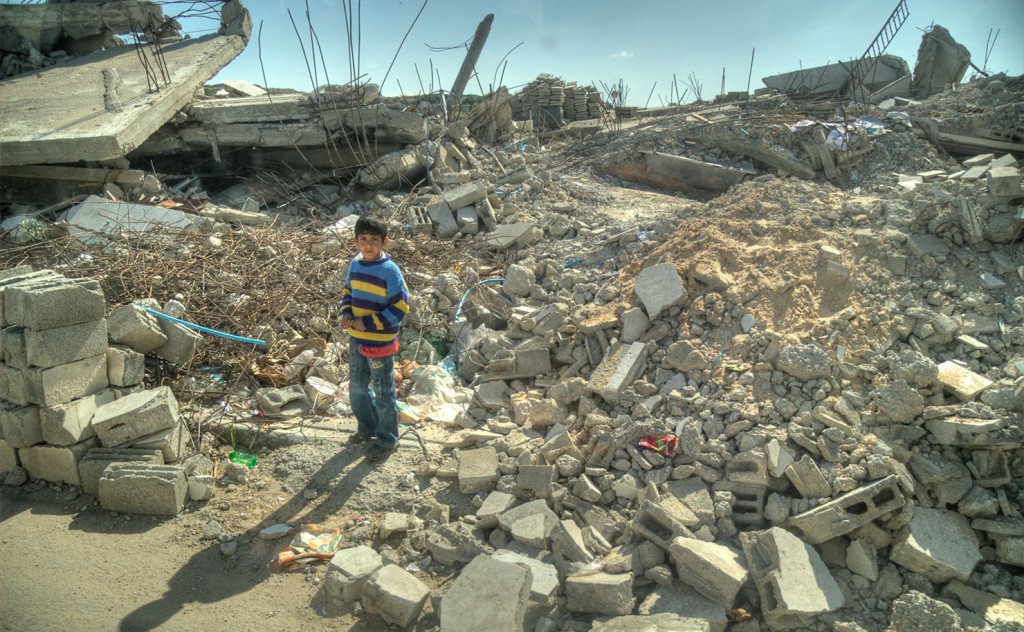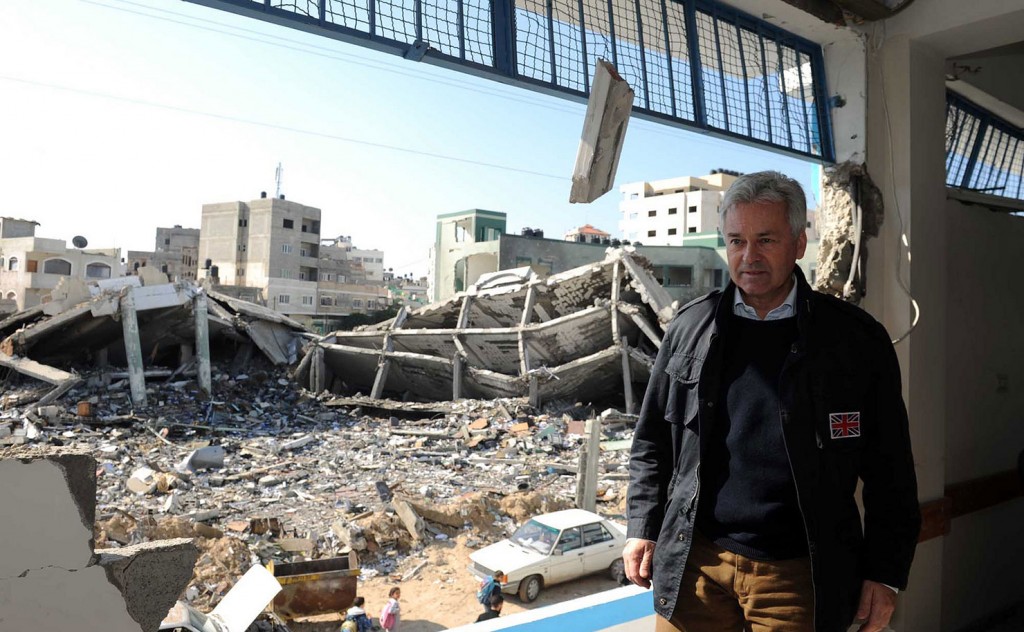For the past month, Israeli snipers have killed almost 50 Palestinians protesting from Gaza about the continued occupation of their country, and the theft of their land. In this special two-part feature, Michael Brull explains the background to the conflict through 19 quotes that unveil the horrendous oppression Palestinians face. Tomorrow, Brull looks specifically at the ongoing slaughter.
The siege on Gaza was imposed in 2006, after Hamas won the elections in the Occupied Palestinian Territories. It was tightened in 2007, when Hamas pre-empted a coup attempt by Fatah.
This is a brief guide to what it has meant, though statistics can hardly convey the misery, suffering and desperation on the ground.
This is also a cursory guide, given the effect of other factors, notably the wars on Gaza in 2008-9, and 2014, and the military coup in Egypt in 2013.
1: Before the siege
Sara Roy, Senior Research Scholar at the Centre for Middle Eastern Studies, Harvard, (“A Dubai on the Mediterranean”, London Review of Books, 3 November 2005).
There is no doubt that the destruction wrought by Israel over the last five years – the demolition of homes (some 4600 between 2000 and 2004), schools, roads, factories, workshops, hospitals, mosques and greenhouses, the razing of agricultural fields, the uprooting of trees, the confinement of the population and the denial of access to education and health services as a consequence of Israeli roadblocks and checkpoints – has been ruinous for Palestinians, especially those in the Gaza Strip. But one need only look at the economy of Gaza on the eve of the uprising to realise that the devastation is not recent. By the time the second intifada broke out, Israel’s closure policy had been in force for seven years, leading to unprecedented levels of unemployment and poverty (which would soon be surpassed). Yet the closure policy proved so destructive only because the thirty-year process of integrating Gaza’s economy into Israel’s had made the local economy deeply dependent. As a result, when the border was closed in 1993, self-sustainment was no longer possible – the means weren’t there. Decades of expropriation and de-institutionalisation had long ago robbed Palestine of its potential for development, ensuring that no viable economic (and hence political) structure could emerge.
2: The siege begins: put them on a diet
Conal Urquhart, “Gaza on brink of implosion as aid cut-off starts to bite”, Guardian, 16 April 2006
“Israel’s policy was summed up by Dov Weisglass, an adviser to Ehud Olmert, the Israeli Prime Minister, earlier this year. ‘The idea is to put the Palestinians on a diet, but not to make them die of hunger,’ he said.”
3: Civilian levers
Dan Murphy, “Israel calls Gaza an ‘enemy entity’”, Christian Science Monitor, 19 September 2007
“Israel declared the Gaza Strip, the Palestinian territory currently controlled by Hamas, to be an “enemy entity” on Wednesday. The move has created speculation that Israel may be trying to turn the general population of Gaza against the group….
Haaretz, a leading left-leaning Israeli daily, said the designation of Gaza as an enemy territory is part of new Israeli measures designed to create hardship in Gaza that might lead average citizens to turn against Hamas. Israel said it would disrupt power and fuel supplies, but would not cut off water.

The security cabinet unanimously approved a number of sanctions to be imposed on the Gaza Strip should the rocket fire on southern Israel continue. The steps are designed to create “civilian levers” that will pressure Gaza’s Hamas rulers to bring the rocket fire to a halt.
“The objective is to weaken Hamas,” Defense Minister Ehud Barak said during the meeting, according to one participant.
4: Economic warfare, Count the calories
Amira Hass, “2,279 Calories per Person: How Israel Made Sure Gaza Didn’t Starve”, Ha’aretz, 17 October 2012
“After a three-and-a-half-year legal battle waged by the Gisha human rights organization, the Coordinator of Government Activities in the Territories has finally released a 2008 document that detailed its “red lines” for “food consumption in the Gaza Strip.”….
In September 2007, the cabinet, then headed by Prime Minister Ehud Olmert, decided to tighten restrictions on the movement of people and goods to and from the Gaza Strip. The “red lines” document was written about four months afterward.
The cabinet decision stated that “the movement of goods into the Gaza Strip will be restricted; the supply of gas and electricity will be reduced; and restrictions will be imposed on the movement of people from the Strip and to it.” In addition, exports from Gaza would be forbidden entirely. However, the resolution added, the restrictions should be tailored to avoid a “humanitarian crisis.”
At a High Court hearing on Gisha’s petition against this policy, government attorneys Gilad Sherman and Dana Briskman, backed by an affidavit from Col. Shlomi Mukhtar of COGAT, explained that “it is the state’s right to decide that it doesn’t intend to have economic ties with, or provide economic assistance to, the other party in the conflict, and to adopt a policy of ‘economic warfare.'”
The “red lines” document calculates the minimum number of calories needed by every age and gender group in Gaza, then uses this to determine the quantity of staple foods that must be allowed into the Strip every day, as well as the number of trucks needed to carry this quantity. On average, the minimum worked out to 2,279 calories per person per day, which could be supplied by 1,836 grams of food, or 2,575.5 tons of food for the entire population of Gaza.”
5: Keep the economy on the brink of collapse
Wikileaks, Cable from US embassy in Tel Aviv to US Secretary of State and others, “Cashless in Gaza?”, 3 November 2008.
As part of their overall embargo plan against Gaza, Israeli officials have confirmed to econoffs on multiple occasions that they intend to keep the Gazan economy on the brink of collapse without quite pushing it over the edge…
6: Their whole civilisation has been destroyed
Mary Robinson, former United Nations High Commissioner for Human Rights, 25 February 2009
“Their whole civilization has been destroyed, I’m not exaggerating. It’s almost unbelievable that the world doesn’t care while this is happening.”
7: The closure constitutes collective punishment
International Committee of the Red Cross, “Gaza closure: not another year!”, 14 June 2010
“The whole of Gaza’s civilian population is being punished for acts for which they bear no responsibility. The closure therefore constitutes a collective punishment imposed in clear violation of Israel’s obligations under international humanitarian law.”
8: Making Gaza liveable in 2020 will require herculean efforts
United Nations Country Team, “Gaza in 2020: A liveable place?”, August 2012
“In the absence of sustained and effective remedial action and an enabling political environment, the challenges which confront the people of Gaza now will only intensify over the coming years to 2020, a period in which another half a million people will be added to the present estimated population of 1.6 million.

Without such action, the daily lives of Gazans in 2020 will be worse than they are now. There will be virtually no reliable access to sources of safe drinking water, standards of healthcare and education will have continued to decline, and the vision of affordable and reliable electricity for all will have become a distant memory for most. The already high number of poor, marginalized and food-insecure people depending on assistance will not have changed, and in all likelihood will have increased.
To ensure that Gaza in 2020 will be “a liveable place,” on-going herculean efforts by Palestinians and partners in such sectors as energy, education, health, water and sanitation, need to be accelerated and intensified in the face of all difficulties.”
9: Gaza is quickly becoming uninhabitable
Filippo Grandi, Commissioner-General of UNRWA, Statement at the Opening Session of the Advisory Commission, 18 November 2013
“I must remind you, once more, that Gaza is quickly becoming uninhabitable, and that further conflict – bound, as before, to affect civilians in Gaza and southern Israel – will erupt unless its causes are addressed.”
10: At current rates it could take 100 years to rebuild Gaza
Oxfam, “Vital building in conflict damaged Gaza to take more than a century at current rate”, 26 February 2015
At current rates it could take more than 100 years to complete essential building of homes, schools and health facilities in Gaza unless the Israeli blockade is lifted, Oxfam warned today as new figures show the amount of vital construction materials entering Gaza dropped last month.
Less that 0.25 percent of the truckloads of essential construction materials needed have entered Gaza in the past three months. Six months since the end of the conflict, the situation in Gaza is becoming increasingly desperate. Oxfam is calling for an urgent end to the blockade of Gaza, which has now been in place for nearly eight years.
Gaza needs more than 800,000 truckloads of construction materials to build homes, schools, health facilities and other infrastructure required after repeated conflicts and years of blockade, according to aid agencies on the ground. Yet, in January only 579 such trucks entered Gaza. This is even less than the 795 trucks that entered the previous month. Around 100,000 people – more than half of them children – are still living in shelters, temporary accommodation or with extended family after their homes were destroyed. Tens of thousands more families are living in badly damaged homes. “
11: Strangled Gaza’s economy
World Bank, “Gaza Economy on the Verge of Collapse, Youth Unemployment Highest in the Region at 60 Percent”, May 21, 2015
Blockades, war and poor governance have strangled Gaza’s economy and the unemployment rate is now the highest in the world according to the latest World Bank economic update. …
The report estimates that Gaza’s GDP would have been about four times higher than it currently is if it weren’t for the conflicts and the multiple restrictions. It also states that the blockade in place since 2007 has shaved around 50 percent off Gaza’s GDP. Unemployment in Gaza is the highest in the world at 43 percent. Even more alarming is the situation of youth unemployment which soared to more than 60 percent by the end of 2014.
“Gaza’s unemployment and poverty figures are very troubling and the economic outlook is worrying. The current market in Gaza is not able to offer jobs leaving a large population in despair particularly the youth,” said Steen Lau Jorgensen, World Bank Country Director for West Bank and Gaza. “The ongoing blockade and the 2014 war have taken a toll on Gaza’s economy and people’s livelihoods. Gaza’s exports virtually disappeared and the manufacturing sector has shrunk by as much as 60 percent. The economy cannot survive without being connected to the outside world.”

Gaza’s real GDP is only a couple of percentage points higher now than it was 20 years ago in 1994, while the population growth is estimated to have increased by about 230 percent over the same period. Consequently, real per capita income in Gaza is 31 percent lower now than in 1994. The 2014 war has reduced Gaza’s GDP by about US$460 million. Construction, agriculture, manufacturing, and electricity sectors were hit the most with output reductions of 83 percent in the construction sector in the second half of 2014 and roughly 50 percent in these other sectors. Gaza became a major source of deficit and the fiscal burden on the Palestinian Authority’s finances amplified by the internal divide. While about 43 percent of PA’s expenditures are spent in Gaza, only 13 percent of its revenues come from Gaza.
Gaza’s population suffers from poor access and quality of basic public services such as electricity, water, and sewerage. Nearly 80 percent of Gaza’s population receives some kind of social assistance, and nearly 40 percent of them still fall below the poverty line. While shocking, these numbers fail to fully convey the difficult living conditions that nearly all Gaza’s residents have been experiencing.
“Even more shocking is the reality that most of Gaza’s 1.8 million residents are confined to an area of 160 km2 and are not able to travel beyond this area without permits. According to the Washington-based Center for Mind-Body-Medicine, as many as one third of Gaza’s children showed signs of post-traumatic stress disorder even before the 2014 armed conflict, now even more,” said Jorgensen.
The status quo in Gaza is unsustainable.”
12: Unemployment and poverty have reached staggering rates
World Bank, “Economic Monitoring Report to the Ad Hoc Liaison Committee”, May 27 2015
“As unambiguously shown by the above analysis, the combination of armed and political conflict and the blockade imposed by Israel in 2007 have had a huge toll on Gaza’s economy. Unemployment and poverty have reached staggering rates and the quality of life for the large majority of Gaza’s citizens is hardly bearable. The feeling of hopelessness is pervasive, in particular following the summer 2014 war. The access and quality of basic services such as electricity, water and sewerage is rapidly deteriorating and pandemics of infectious diseases are a real threat.”
13: Infant mortality rate has risen for the first time in five decades
United Nations Relief and Works Agency, “Infant mortality rate rises in Gaza for first time in fifty years”, 8 August 2015
“The infant mortality rate in Gaza has risen for the first time in five decades, according to an UNRWA study, and the Agency’s Health Director says the blockade may be contributing to the trend.…
The number of babies dying before the age of one has consistently gone down over the past several decades in Gaza, from 127 per 1,000 live births in 1960 to 20.2 in 2008. At the last count in 2013, however, it had risen to 22.4 per 1,000 live births.
The rate of neonatal mortality, which is the number of babies that die before they reach four weeks, has also gone up significantly in Gaza, from 12 per 1,000 live births in 2008 to 20.3 in 2013.
“Infant mortality is one of the best indicators for the health of the community,” said Dr. Akihiro Seita, Director of the UNRWA health programme. “It reflects on the mother and child’s health and in the UN Millennium Development Goals, it is one of the key indicators.”
14: Rash of Gaza suicides
Avi Issacharoff, Times of Israel, 23 February 2016
“Rash of Gaza suicides points to rising poverty, despair”
15: Israel permits 16 percent of infrastructure needed for clean drinking water
Oxfam, “Failing Gaza: undrinkable water, no access to toilets and little hope on the horizon”, 15 April 2017
Now less than four percent of fresh water is drinkable and the surrounding sea is polluted by sewage. Yet the international community is failing to do enough to protect the health and dignity of almost 2 million people who have nowhere else to go.
Israel’s blockade of Gaza severely limits materials from entering, making it incredibly difficult to develop water and sanitation infrastructure to meet the needs of a growing population.…
Almost 3,000 items needed to build infrastructure to meet the demand for water and sanitation are still waiting for approval to enter through the mechanism, which requires Israeli approval of projects as well as individual items. Recent research by Oxfam found that just 16% of items submitted for approval through the GRM for the water sector have actually made it into Gaza, a damning success rate that mirrors the dynamics of the blockade itself.

The international community, including governments such as the UK, Germany and the Netherlands who fund the mechanism, must ensure that the security concerns of Israel do not violate the rights of civilians under occupation and therefore must immediately increase efforts to pressure Israel to allow the entry of materials. There must be a coordinated response to the Government of Israel if progress is not made in ending unlawful Israeli-imposed restrictions.
Without urgent and fundamental change, the crisis will spiral out of control, construction will stagnate and the UN’s prediction that Gaza will be unliveable by 2020 will be a reality.
16: Systemic collapse of battered infrastructure pending
International Committee of the Red Cross, “Electricity shortages affect all aspects of life in Gaza”, 15 May 2017
“Severe power and fuel shortage has reached a critical point in Gaza, endangering essential services including health care, wastewater treatment and water provision.
Without immediate intervention, a public health and environment crisis is looming. Currently, people in Gaza only have power for six hours a day, in most cases. All aspects of life in Gaza have been affected. As a result, a systemic collapse of an already battered infrastructure and economy is impending.”
17: Living conditions deteriorating faster than predicted
Robert Piper, the UN Coordinator for Humanitarian Aid and Development Activities, “Living conditions in Gaza ‘more and more wretched’ over past decade, UN finds”, 11 July 2017
“A decade after Hamas seized the Gaza Strip, the living conditions for two million people in the Palestinian enclave are deteriorating “further and faster” than the prediction made in 2012 that the enclave would become “unlivable” by 2020, a new United Nations report has found.
“Gaza has continued on its trajectory of ‘de-development’, in many cases even faster than we had originally projected,” said Robert Piper, the UN Coordinator for Humanitarian Aid and Development Activities, in a press release on the new report, “Gaza – 10 years later.”
18: Almost all of the drinking water is undrinkable
Zafrir Rinat, “Ninety-seven Percent of Gaza Drinking Water Contaminated by Sewage, Salt, Expert Warns”, Ha’aretz, 21 January 2018
“Almost all of the drinking water in the Gaza Strip is impotable because of sewage pollution or high salinity levels, according to data presented last week by a hydrologist who advises the Palestinian Water Authority.…
Moreover, almost 90 percent of the drinking water in Gaza exceeds the maximum salinity standard of the World Health Organization and is expected to become even more saline in the years to come….
The electricity shortage also prevents the Strip’s sewage treatment plants from operating, allowing untreated sewage water to flow directly into the sea. The sewage reaches the adjacent Israeli coastal cities of Ashkelon and Ashdod, but first it pollutes Gaza’s beaches, Yaqoubi said.”
19: Gaza’s health care system collapsing
Amira Hass, “Gaza Health System Collapsing: 40 Percent of Medicine Runs Out”, Ha’aretz, 8 February 2018
“At the end of January, Gaza’s public health care system had run out of 206 essential medicines – that is 40 percent of medications included in the basic Palestinian health basket. A further 27 drugs – or 6 percent of the 516 medications in the basket – were about to be depleted within days or weeks. There is a dire shortage in essential drugs such as those required for performing cardiac angiographies, treating cancer and autoimmune diseases and performing dialysis. Of a list of 853 disposable medical equipment items, 220 were expected to be unobtainable by the end of January.…
The unavailability of drugs has been overshadowed in the last year by the worsening electricity shortage, with a daily supply of only four to eight hours. Consequently, health facilities rely on generators and a supply of emergency fuel which, according to a UN warning last Monday, will be exhausted within the next week. A January report by the World Health Organization warns that 1,715 patients will be in immediate life-threatening situations if hospitals run out of fuel.”
Donate To New Matilda
New Matilda is a small, independent media outlet. We survive through reader contributions, and never losing a lawsuit. If you got something from this article, giving something back helps us to continue speaking truth to power. Every little bit counts.




